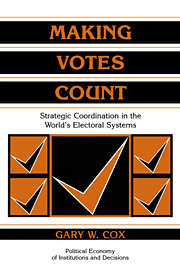Book contents
- Frontmatter
- Contents
- List of tables and figures
- Series Editors' Preface
- Preface
- PART I INTRODUCTION
- PART II STRATEGIC VOTING
- PART III STRATEGIC ENTRY
- PART IV ELECTORAL COORDINATION AT THE SYSTEM LEVEL
- 10 Putting the constituencies together
- 11 Electoral institutions, cleavage structures, and the number of parties
- PART V COORDINATION FAILURES AND DEMOCRATIC PERFORMANCE
- PART VI CONCLUSION
- APPENDICES
- References
- Subject Index
- Author Index
10 - Putting the constituencies together
Published online by Cambridge University Press: 05 August 2012
- Frontmatter
- Contents
- List of tables and figures
- Series Editors' Preface
- Preface
- PART I INTRODUCTION
- PART II STRATEGIC VOTING
- PART III STRATEGIC ENTRY
- PART IV ELECTORAL COORDINATION AT THE SYSTEM LEVEL
- 10 Putting the constituencies together
- 11 Electoral institutions, cleavage structures, and the number of parties
- PART V COORDINATION FAILURES AND DEMOCRATIC PERFORMANCE
- PART VI CONCLUSION
- APPENDICES
- References
- Subject Index
- Author Index
Summary
Thus far, this book has dealt with issues of local coordination: how voters in a given electoral district coordinate their suffrages; how candidates and parties, again at the district level, coordinate their entry decisions. Scholarly arguments about the effect of electoral systems on party systems, from Duverger onward, have not stopped with these district-level considerations. Instead, they have gone further and claimed that electoral rules also affect the larger stage of national politics, because national parties link politicians from many electoral districts together for purposes of electoral campaigning and governance.
In this chapter, I consider this appeal to the existence of national parties, and the phenomenon of cross-district linkage of legislative candidates more generally. I shall argue that the standard linkage argument, in particular, that advanced in support of Duverger's Law, fails; and that better linkage arguments entail the same kinds of social and institutional considerations encountered previously in the book. Under the heading of “institutional considerations” I stress in particular the importance of the rules determining the selection and power of the chief executive (whether president or prime minister). This discussion sets the stage for the empirical analysis presented in Chapter 11.
A second topic that I investigate in this chapter concerns how taking a multi-district view of things might affect the topics considered in the previous two parts of the book: strategic voting and strategic entry.
- Type
- Chapter
- Information
- Making Votes CountStrategic Coordination in the World's Electoral Systems, pp. 181 - 202Publisher: Cambridge University PressPrint publication year: 1997

